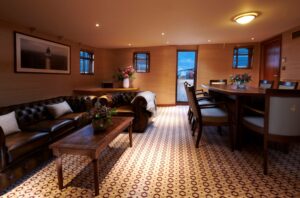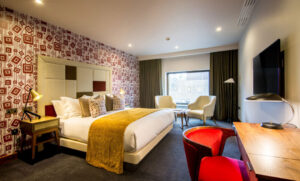A residential building is not merely a structure; it is a canvas where inhabitants create the backdrop of their lives. The furniture within these spaces plays a pivotal role in transforming a house into a home. In this article, we will explore the considerations, trends, and key elements involved in selecting furniture for residential buildings to create spaces that seamlessly blend functionality, comfort, and style.
Considerations for Residential Building Furniture:
Functionality and Lifestyle:
The first and foremost consideration when choosing furniture for residential buildings is functionality. Each piece should serve a purpose and align with the lifestyle of the inhabitants. For example, families may prioritize durable and stain-resistant materials, while individuals or couples may lean towards stylish and compact designs.
Space Planning:
Effective space planning is essential, especially in urban residential buildings where space is often limited. Furniture should be chosen with consideration for room dimensions, traffic flow, and the overall layout. Opting for multi-functional pieces, such as storage beds or nesting tables, can maximize space utility without compromising on aesthetics.
Durability and Maintenance:
Residential furniture is subjected to daily use, making durability a critical factor. Materials that withstand wear and tear, such as solid woods, quality upholstery fabrics, and stain-resistant surfaces, contribute to the longevity of furniture. Additionally, selecting furniture that is easy to clean and maintain ensures a consistently fresh and inviting living environment.
Aesthetic Harmony:
A cohesive design aesthetic ties together the various elements within a residential space. Whether embracing a modern, traditional, minimalist, or eclectic style, consistency in design enhances the visual appeal of the entire building. Consider factors such as color schemes, textures, and design motifs to create a harmonious and inviting atmosphere.
Customization and Personalization:
Each residence is a unique reflection of its occupants, and furniture should follow suit. Consider furniture brands or designers that offer customization options, allowing residents to tailor pieces to their preferences. Personal touches, such as custom upholstery or bespoke finishes, contribute to a sense of individuality within the living space.
Trends in Residential Building Furniture:
- Multifunctional Furniture: With the increasing emphasis on optimizing space, multifunctional furniture has gained popularity. Items like sofa beds, dining tables with built-in storage, and modular furniture allow residents to adapt their living spaces to various needs, making them ideal for apartments and smaller homes.
- Sustainable and Eco-Friendly Choices: The global shift towards sustainable living has influenced the choice of materials in residential furniture. Brands are increasingly using eco-friendly materials such as reclaimed wood, bamboo, and recycled metals. Residents are drawn to furniture that aligns with their commitment to environmental responsibility.
- Smart Furniture Integration: In the age of smart homes, furniture is not exempt from technological integration. Furniture with built-in USB ports, wireless charging pads, and smart lighting solutions caters to the tech-savvy residents seeking a seamless blend of convenience and comfort.
- Natural and Organic Elements: There is a growing trend towards incorporating natural and organic elements into residential furniture. This includes furniture crafted from natural materials like rattan, jute, and organic cotton. The use of earthy tones and nature-inspired patterns enhances a sense of tranquility within the living space.
- Mixing Vintage with Modern: A trend that continues to gain traction is the artful blending of vintage and modern furniture. Residents are combining classic, timeless pieces with sleek, contemporary designs to create a curated and eclectic living environment that tells a story of both the past and the present.
Key Furniture Pieces for Residential Buildings:
- Sofas and Sectionals: The centerpiece of any living room, sofas and sectionals set the tone for comfort and style. Consider the size of the room and the desired seating capacity when choosing these pieces. Modular and customizable options allow residents to adapt these focal points to their specific needs.
- Dining Tables and Chairs: The dining area is a social hub within a residence, and the furniture in this space should encourage shared meals and conversations. Styles range from traditional to modern, with options such as extendable tables for flexibility and stackable chairs for easy storage.
- Beds and Bedroom Furniture: The bedroom is a sanctuary, and selecting the right bed and bedroom furniture is crucial for a restful retreat. From storage beds to nightstands and dressers, the bedroom furniture should cater to both comfort and organization.
- Storage Solutions: Ample storage is essential for maintaining an organized and clutter-free living space. Consider furniture with built-in storage, such as ottomans with hidden compartments, bookshelves, and entertainment units that provide both functionality and style.
- Home Office Furniture: With the rise of remote work, dedicated home office spaces are becoming increasingly common. Choose ergonomic desks, comfortable chairs, and storage solutions to create a productive and aesthetically pleasing work environment within the residence.
Conclusion:
Selecting furniture for residential buildings is an art that involves understanding the needs, preferences, and lifestyle of the residents. Whether it’s creating a cozy living room, a functional dining area, or a serene bedroom, each piece contributes to the overall ambiance of the home. By considering factors such as functionality, space planning, durability, and aesthetic harmony, residents can curate a living space that not only meets their practical needs but also reflects their unique personality and style. As trends evolve and new innovations emerge, the world of residential building furniture continues to offer an exciting palette for residents to craft homes that are both comfortable and visually stunning.
Follow Us on Linkedin




